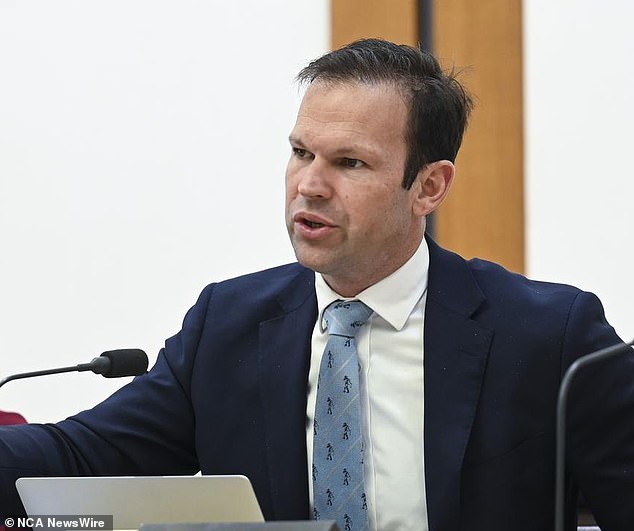Could a publicly owned bank be the answer to financial institutions’ growing trend of going cashless and disappearing from regional Australia?
The government is being urged to explore establishing a state-owned bank to ensure Australians have access to financial services as more banks go cashless and close physical stores.
A Senate committee investigating the impact of branch closures on consumers and businesses recommended in its final report on Friday that the existing Banking Code of Conduct be made mandatory.
Under the code, banks would be required to carry out ‘meaningful’ consultation with communities before closing a branch, and fund the transition and ongoing services to ensure access to cash and essential banking services in the event of a closure.
Hundreds of branches of the Big Four banks have closed across Australia in recent years and even more have gone ‘cashless’ (photo: Westpac Bank branch with a closed sign on the window)

Matt Canavan is leading the Senate inquiry into nationwide branch closures
To enforce the mandatory code, a regulator would have the power to approve or delay closure requests, penalizing banks if consultation or disclosure requirements were not met.
In addition, the committee recommended that the Australian Competition and Consumer Commission be tasked with investigating the barriers customers face when switching banks.
The government should also support the establishment of community bank branches, the inquiry’s final report argued, with the cost of a new fund to help set up ‘community branches’ supplemented through an increase in the Major Banks Levy.
The committee’s final report also recommended an expansion of the Bank@Post service, including forcing ANZ to sign up to the service.
In individual deals with a cumulative value of $90 million, customers at Commonwealth Bank, Westpac and NAB, in addition to a number of smaller banks, already have access to Australia Post’s 3,500 branches for basic services such as cash withdrawals and deposits under the program.
Although ANZ has not offered its services through Bank@Post since 2019, CEO Shayne Elliott has indicated he is open to a return after the merger with Suncorp is completed.
While the committee did not recommend immediately establishing a state-owned bank, it did state that a feasibility study should explore such a proposal, possibly in combination with the existing Bank@Post model.
But Anna Bligh, CEO of the Australian Banking Association (ABA), warned that a state-owned bank was a treacherous proposition.
“Given the catastrophic failures of state-owned banks in this country in the past, Australians should be wary of suggestions for a new taxpayer-funded state-owned bank,” Ms Bligh said.

ABA boss Anna Bligh warned against setting up a state-owned bank
“A major state-owned bank would seriously jeopardize the continued viability of the many small and medium-sized banks serving customers in regional and rural Australia.”
The spectacular implosion of state-owned banks in Victoria and South Australia in the early 1990s was among the worst economic disasters in Australia’s recent history, ultimately leading to the defeat of two Labor state governments.
The committee’s chairman, Queensland Nationals Senator Matt Canavan, accused the big banks of not acting in good faith over the closure of branches in regional towns. “A tougher and more proactive approach is now needed to rebuild financial services in the bush,” Canvan said.
“The big banks have been the main reason why there is a financial desert in so many rural towns and so it is perfectly reasonable for them to pay a small fee to help rebuild financial services in the bush.”
The inquiry held hearings in a range of regional centres, including Cloncurry, Tom Price and Launceston, with witnesses reporting that bank branches were an essential service in many communities, especially for the elderly and those without internet access or poor financial literacy.
Businesses with heavy cash transactions in regional and remote areas also reported regularly having to travel long distances to make deposits because they lacked secure premises to maintain significant cash reserves.

The use of cash in Australia has shifted to tap-and-go, cards and electronic transfers rather than physical cash in recent years, largely due to its convenience
Westpac closed 167 branches last year, according to data released by S&P Global Market Intelligence. Commonwealth Bank closed 73, ANZ closed 72, while NAB closed 72. These figures cover urban, regional and rural areas.
Data from the ABA shows that consumers have overwhelmingly switched to online banking in recent years, with 98.9 percent of transactions now made via the internet or banking apps.
Another 0.7 percent of transactions are made in physical branches, while the remaining 0.4 percent are carried out through telephone and chat box functions.
Similarly, the rise in the share of digital wallet transactions and associated decline in cash use has also reduced branch use, with only 12 percent of consumers reporting visiting their local bank on a weekly basis.
CBA and Westpac have extended their moratoriums on branch closures until December 2026 and January 2027 respectively. ANZ has committed to pausing closures until the culmination of the investigation, while NAB has continued to close regional locations.
